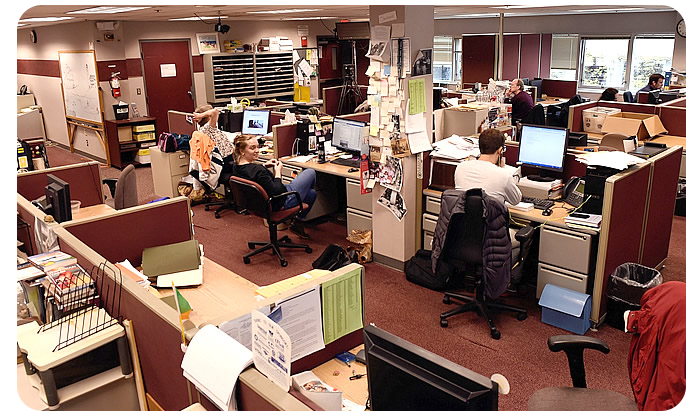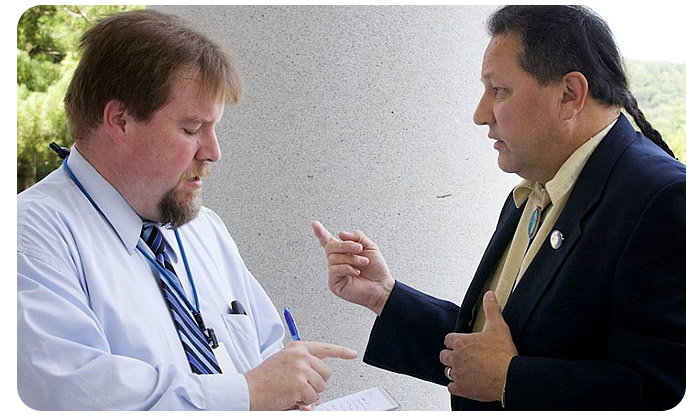By Alex Eng,
Bulletin Correspondent

How are boots-on-the-ground reporters balancing faster news cycles with long-term financial struggles in the news industry?
By getting ahead of the curve, publishing digital-first, and training for new reporting technology, according to interviews with reporters and news executives at New England newspapers.
Journalists at New England newspapers said that, although faced with declining print circulation and shrinking newsroom staffs, they are producing more news at a faster pace than ever before and publishing content — including online, photos, videos and live streaming — on multiple platforms.
“Definitely, we work a lot faster, and the way we write the stories has changed a lot,” said Christopher Cousins, statehouse bureau chief with the Bangor (Maine) Daily News. “There always was pressure in journalism … But now, if some news breaks, we do everything we can to get something up on the website as soon as possible.”
Although print circulation at the Bangor Daily News declined from 100,000 to about 35,000 during the past decade, switching to digital-first publishing has kept the news cycle robust, Cousins said. Now, the Daily News publishes 150 to 200 items a day online.
Covering breaking news is much faster now. Reporters can send information back from the field while also shooting photos and videos on their smartphones, live tweeting, or streaming events on Facebook Live. Back at the office, reporters can simultaneously assemble content in real time over the Internet and post multimedia stories online before events even end, Cousins said.
Working on a 24-hour news cycle while working in multiple mediums has placed more pressure on journalists, however, Cousins said.
“All of us are doing more than we used to do. Reporters who used to write stories are now taking pictures and doing Facebook and Twitter,” Cousins said. “Editors are dealing with shoveling more content through the process. I think we’re all doing the jobs that two or three people used to do 10 or 15 years ago.”
As at the Bangor Daily News, reporters at The Burlington (Vt.) Free Press also do the full package of writing a story, shooting a brief video, taking photos and publishing all of the content online. Denis Finley, executive editor there, said requiring journalists to be multipurpose was a necessity, given shrinking newsroom staffs.
“I think the separation of powers only exists at the very biggest papers, where you have enough people to be kind of compartmentalized,” Finley said. “This has been going on and evolving for around 10 years. It’s not just small papers. Almost every paper in the country has to do this in some form or another.”
Reporters are taking photos because photography and videography teams, while talented, are shrinking, and reporters have to pick up the job of getting visuals for their stories, Finley said.
Given the responsibilities reporters have now, preventing work overload is another challenge in today’s fast-paced industry, Finley said. Finley said he tries to balance how much each of the 18 Free Press news staffers is responsible for day-in and day-out so they can continue producing high-quality journalism.
“We try to be careful and keep tabs on who’s doing what. We can tell if somebody’s overloaded,” Finley said. “You can only squeeze so much out of people.”
That means some reporters are pulled from new assignments if they need time to work on other complex multimedia stories, while others are recruited to help each other out with stories if the workload becomes too much to handle, Finley said.
These days, much of the multimedia training that makes journalists so versatile comes on the job, meaning people have to learn as they go, said Michael Rifanburg, publisher of the Amherst (Mass.) Bulletin, and the Daily Hampshire Gazette and The Valley Advocate, both based in Northampton, Mass.
“Fifteen years ago, everyone’s job was contained within this cylinder,” Rifanburg said. “Now, we do more cross-training where we have reporters shooting photos and video or sending in reports from the field electronically.”
It’s not easy for veteran journalists, who are used to traditional reporting and writing, to learn the new technologies that modern newsrooms use, so staff members help each other out, Rifanburg said. Moreover, young reporters are more in tune with social media and multimedia reporting, which will keep the newsroom and industry updated amid changes in technology.
“Many reporters are coming to us with a lot of that training right out of school. They’ve learned how to think on the fly and use smartphones for all different purposes,” Rifanburg said. “As we evolve as a newsroom, we’re making sure that all the members of the team can do the tasks that we need them to do.”
Still, most of those interviewed agreed that the core function of journalism is to inform, regardless of the medium on which stories are published.
The function of getting news to as many people as possible is not changing, said Timothy Dwyer, executive editor of The Day of New London, Conn.
“We all embrace the idea of we no longer dictate how people consume our stories. We’ll give them our stories anywhere, anytime they want it, and how they want it,” Dwyer said. “It gives us more access to more people.”
Dwyer said websites, video, photo galleries, live streaming, social media and mobile publishing are all grabbing new readers with more engaging content, as some people leave print behind,.
The industry will simply continue to evolve as new technologies arise, while still informing and educating the public, said Sandy Bucknam, managing editor of The Telegraph of Nashua, N.H., and four sister newspapers in New Hampshire, The Cabinet of Milford, the Merrimack Journal, Hollis Brookline Journal, and Bedford Journal.
“People who are dedicated to the industry have always wanted to do a thorough job in getting the news out to as many people as possible as quickly as possible,” Bucknam said. “As technology evolves, we have to evolve with technology and make sure that we’re presenting the paper to the greatest number of people possible using the methods that they prefer to receive it.”


‘All of us are doing more than we used to do. Reporters who used to write stories are now taking pictures and doing Facebook and Twitter. Editors are dealing with shoveling more content through the process. I think we’re all doing the jobs that two or three people used to do 10 or 15 years ago.’
—Christopher Cousins, Statehouse bureau chief
Bangor (Maine) Daily News

‘We all embrace the idea of we no longer dictate how people consume our stories. We’ll give them our stories anywhere, anytime they want it, and how they want it. It gives us more access to more people.’
—Timothy Dwyer, Executive Editor
The Day, New London, Conn.

‘As technology evolves, we have to evolve with technology and make sure that we’re presenting the paper to the greatest number of people possible using the methods that they prefer to receive it.’
—Sandy Bucknam, Managing editor
Telegraph of Nashua, NH
‘We try to be careful and keep tabs on who’s doing what. We can tell if somebody’s overloaded. You can only squeeze so much out of people.’
—Denis Finley, Executive editor
Burlington (VT) Free Press
‘Definitely, we work a lot faster, and the way we write the stories has changed a lot. There always was pressure in journalism … But now, if some news breaks, we do everything we can to get something up on the website soon as possible.’
—Christopher Cousins
Bulletin photos by Julia Aparicio
